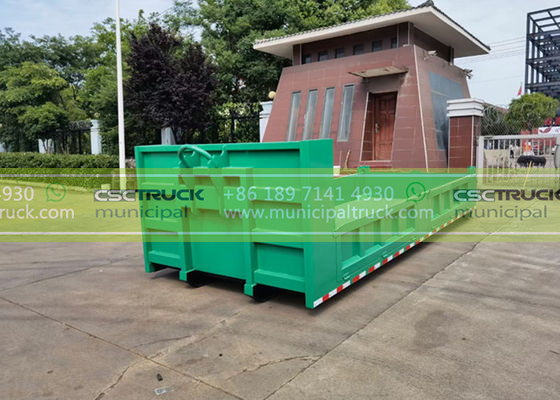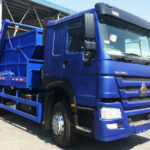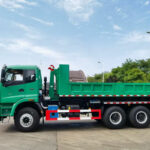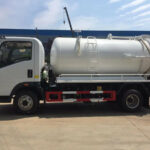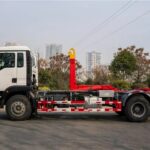The symphony of progress on a construction site is underscored by a less glamorous, yet utterly critical, reality: the relentless generation of waste. From jagged concrete rubble and twisted rebar to discarded packaging, soil spoils, and occasional hazardous materials, construction debris is diverse, voluminous, and inherently challenging to manage. Traditional waste collection methods often falter in this demanding environment, leading to logistical bottlenecks, safety hazards, and escalating disposal costs. Enter the hook loader garbage truck – a paragon of heavy-duty versatility and efficiency purpose-built to conquer the unique waste management challenges of the modern construction site. Far more than just a hauler, this robust system functions as a mobile waste transfer station, embodying the versatility, durability, and operational intelligence required to keep projects on schedule, sites safe, and environmental compliance uncompromised. Its unique design philosophy centers on container interchangeability, transforming a single truck chassis into a multi-functional asset capable of handling an astonishing range of waste streams with unprecedented speed and security, fundamentally redefining debris removal logistics.
Engineering Muscle: The Anatomy of a Hook Loader System
At the heart of the hook loader’s superiority lies its ingenious and robust hydraulic mechanism, a feat of engineering designed for extreme service. Unlike conventional garbage trucks with fixed bodies, the hook loader’s defining feature is its detachable intermodal container system, enabled by a powerful hydraulic hook arm mounted on a reinforced chassis:
- The Hydraulic Hook Arm System: This is the core muscle. A massive, articulating steel arm, powered by high-capacity hydraulic cylinders, extends, lowers, engages, lifts, and secures specially designed containers. Precision engineering ensures immense lifting capacity (often exceeding 20 tons) and precise control, allowing operators to handle fully loaded containers safely even on uneven or confined terrain. The hydraulic hook arm system incorporates multiple safety interlocks to prevent accidental disengagement during transport.
- Heavy-Duty Chassis & Powerplant: Built to endure punishing loads and rough site conditions, hook loader trucks utilize specialized multi-axle chassis, often with reinforced frames and heavy-duty suspensions (like walking beam or air-ride). Power is provided by large-displacement diesel engines, generating the necessary torque not just for propulsion but to drive the significant hydraulic pumps required for rapid container loading and unloading under maximum load.
- Intermodal Container Compatibility: The true genius lies in the standardized roll-off containers or skip bins. These robust, typically steel, containers feature standardized pockets or lifting points designed to interface seamlessly with the hook arm. Available in myriad sizes (commonly 20, 30, and 40 cubic yards) and specialized configurations (e.g., open-top for bulky debris, closed-top with doors for secure or weatherproof transport, compaction units for lighter, bulkier waste), these containers become mobile waste bunkers.
- Advanced Control Systems: Modern hook loaders feature sophisticated operator interfaces, often with joystick controls and digital displays providing real-time feedback on load weight, container position, hydraulic pressure, and system diagnostics. Enhanced stability systems monitor load distribution and chassis tilt, providing warnings or automatically limiting functions to prevent rollovers, a critical safety feature on unstable ground.
Unmatched Operational Efficiency on the Construction Frontline
The hook loader system delivers unparalleled efficiency gains specifically tailored to the chaotic and dynamic environment of construction sites, directly impacting project timelines and bottom lines:
- Container Interchangeability & Multi-Functionality: This is the transformative advantage. A single hook loader truck can service multiple roll-off containers strategically placed around the site. When one container is full, the truck swiftly detaches it (often in under 3 minutes), leaves it for immediate replacement by an empty one, and transports the full container directly to the disposal facility. This eliminates the prolonged downtime associated with waiting for a dedicated truck to arrive and manually load debris. Different containers can be designated for specific waste streams (e.g., concrete, wood, metal, general waste), facilitating on-site waste segregation crucial for recycling and cost-effective disposal.
- Rapid Turnaround & Reduced Site Traffic: The speed of container exchange drastically reduces the time the truck spends on the active site. This minimizes disruption to critical construction activities and enhances overall site safety by reducing large vehicle movements. Compared to multiple trips required by smaller-capacity trucks, one hook loader run with a large container significantly cuts the number of vehicle entries and exits.
- Optimized Logistics & Just-in-Time Service: Project managers can schedule container swaps based on fill levels and project phases. Containers can be dropped off precisely when needed and removed just as quickly when full, optimizing space utilization on often cramped sites. This “just-in-time” approach prevents overflowing bins and keeps the site cleaner and safer.
- Handling Extreme Loads & Diverse Debris: The inherent strength of the system allows it to handle the heaviest, most abrasive construction debris – broken concrete, bricks, saturated soil, scrap metal – that would damage or overload conventional rear loader garbage truck or side loader garbage truck bodies. Open-top containers facilitate easy loading by excavators or front-end loaders directly where the debris is generated.
Enhancing Safety and Ensuring Compliance in Hazardous Environments
Construction sites are inherently high-risk zones. The hook loader system incorporates design features and operational protocols that actively enhance safety and simplify adherence to stringent environmental regulations:
- Minimized Manual Handling: Significantly reduces the need for workers to manually lift or handle debris into truck hoppers. Debris is loaded directly into ground-level containers using machinery (loaders, excavators), or tipped from smaller carts. This drastically lowers the risk of musculoskeletal injuries and exposure to sharp or hazardous materials.
- Secure Containment & Transport: Heavy-duty roll-off containers provide robust containment, preventing debris from falling or blowing off during transport. Closed-top containers offer security against scavenging, prevent windblown litter, and contain dust or hazardous materials. Secure locking mechanisms ensure containers remain firmly attached to the chassis during transit over rough terrain or highways.
- Stability and Control: The low center of gravity when transporting a secured container, combined with advanced stability monitoring systems, provides superior handling compared to top-heavy compactor trucks, especially on uneven ground common during early and late phases of construction.
- Facilitating Regulatory Compliance: The ability to segregate waste into different containers directly on-site simplifies compliance with increasingly stringent waste diversion and recycling mandates. Hazardous materials (asbestos tile, contaminated soil, chemicals) can be isolated in designated, labeled containers for proper disposal. Detailed manifests track waste streams from the specific container through to disposal or recycling facilities, providing a clear audit trail required by environmental agencies (e.g., EPA, local DEPs).
Economic Advantages: Driving Down Debris Removal Costs
Beyond operational efficiency, the hook loader system delivers compelling financial benefits that directly impact a construction project’s budget:
- Reduced Fleet Requirements & Capital Expenditure: One hook loader truck can effectively replace the need for multiple smaller trucks (like smaller roll-offs or modified dump trucks) or the constant scheduling of different specialized collection services. This reduces the capital investment required for waste management equipment.
- Maximized Hauling Efficiency: Transporting large volumes (30-40 cubic yards) in a single trip maximizes payload per journey, reducing fuel consumption, driver hours, and overall mileage compared to numerous trips by smaller vehicles. The direct transport of the full container eliminates transfer station fees often incurred when using smaller trucks that must offload into larger trailers.
- Minimized Labor Costs: The speed of container exchange and the reduction in manual loading labor translate directly into lower labor expenditures. Operators spend less time on-site per load collected.
- Reduced Disposal Costs Through Segregation: Effective on-site segregation using multiple containers allows clean, recyclable materials (concrete, metal, clean wood) to be separated from landfill-bound waste. Recycling is often significantly cheaper than landfill tipping fees, and segregated materials may even generate rebates.
- Lower Site Restoration & Incident Costs: Efficient waste removal and secure containment minimize debris-related accidents (trips, falls, material strikes) and prevent environmental incidents (spills, dust, runoff), avoiding associated fines, cleanup costs, and project delays.
Sustainability and Future-Proofing Construction Waste
The hook loader system aligns powerfully with the construction industry’s growing focus on sustainability and responsible resource management:
- Enabling High Recycling Rates: The cornerstone of construction waste reduction is effective segregation at the source. The ease of deploying multiple containers for different streams makes achieving high recycling and diversion rates practical and efficient on busy sites, diverting tons of material from landfills.
- Material Recovery & Circular Economy: Segregated materials collected in hook loader containers are prime candidates for processing and reintroduction into the supply chain as recycled aggregates, scrap metal, or biomass fuel, contributing directly to the circular economy.
- Reduced Carbon Footprint: Maximizing payload per trip and minimizing total vehicle miles traveled directly reduces the carbon emissions associated with waste hauling for the project. Efficient logistics mean fewer trucks on the road.
- Adaptability to Innovation: The intermodal container system is inherently adaptable. Containers can be fitted with compaction units to increase capacity for lighter waste, specialized liners for liquid or hazardous waste, or even modified for emerging waste streams. The core hook loader chassis can be upgraded or adapted over its long lifespan.
- Synergy Within Waste Management Fleets: While the hook loader garbage truck excels in the demanding, high-volume, heavy debris environment of construction and demolition, it represents one vital component within a comprehensive municipal or industrial waste management fleet. Its focus on containerized, bulk debris removal complements the roles of other specialized vehicles: the rear loader garbage truck, optimized for high-volume curbside collection of bagged and containerized refuse in urban settings using its hydraulic compactor; and the side loader garbage truck, designed for efficient automated or semi-automated collection from standardized carts along residential routes. Together, these distinct platforms – the versatile hook loader for bulk and industrial needs, the high-capacity rear loader for dense municipal waste streams, and the efficient side loader for automated residential collection – provide the tailored solutions necessary to manage the complex and varied waste landscape effectively, ensuring efficiency, safety, and environmental responsibility across all sectors. The hook loader’s unique capabilities ensure that when the challenge involves the formidable waste streams of a construction zone, the ideal solution is already on the job.

